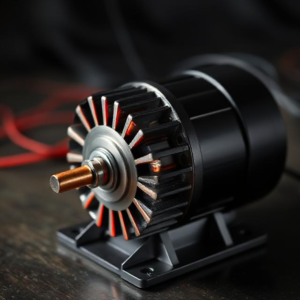How Does an Electric Motor Work? (DC Motor Explained)
An electric motor is a device that converts electrical energy into mechanical energy (motion). DC motors (Direct Current motors) are among the most common types, operating on basic principles of magnetism and electricity. In a DC motor, electricity is used to generate a magnetic field that interacts with another magnetic field, causing the rotor to spin. The commutator ensures the motor continues running by reversing the current to maintain the motion.
Let’s break down the working of a DC motor step by step to make it easier to understand:

Key Parts of a DC Motor
- Stator
- The stationary part of the motor that creates a magnetic field. It typically contains either permanent magnets or electromagnets.
- Rotor (Armature)
- The rotating part of the motor. Usually, it is a coil of wire positioned inside the stator’s magnetic field.
- Commutator
- A switch that reverses the direction of current flow through the rotor every half-turn. This ensures the rotor continues spinning in the same direction.
- Brushes
- Small pieces of conductive material (often carbon) that touch the commutator, allowing the electric current to flow into the rotor.
- Power Supply
- The source of electricity powering the motor. For a DC motor, this is typically a battery or DC power supply.
How Does a DC Motor Work?
1. Electric Current and Magnetic Fields
- When the motor is connected to a power supply (e.g., a battery), electric current flows through the coil of the rotor. This current creates a magnetic field around the coil.
2. Interaction with Stator’s Magnetic Field
- The magnetic field generated by the rotor interacts with the stator’s magnetic field. The stator’s field could come from permanent magnets or electromagnets. According to the Magnetic Force Law (Lorentz force), opposite magnetic poles attract, while like poles repel.
3. Force on the Rotor
- The interaction of the magnetic fields creates a force on the rotor, causing it to rotate. This is the fundamental principle of how electric motors work: magnetic fields pushing and pulling each other to produce motion.
4. Commutator Reverses Current
- As the rotor turns, the commutator periodically reverses the direction of the current in the coil. Without this reversal, the rotor would stop turning once it aligns with the magnetic field, as the forces would cancel each other out.
- The commutator ensures the rotor continues spinning by reversing the current and preventing it from stopping.
5. Rotation Continues
- The rotor keeps spinning as the brushes maintain contact with the commutator, allowing the motor to continue running. This constant interaction between the rotor’s magnetic field and the stator’s magnetic field generates continuous motion.
Why Does the Rotor Keep Spinning?
The key to continuous rotation lies in the reversal of the current. If the current wasn’t switched, the rotor would eventually stop, because the opposing magnetic fields would create a force that resists further rotation.
The commutator and brushes work together to reverse the current, ensuring the rotor keeps spinning in one direction and providing continuous motion.
Summary
- Electricity flows into the motor, creating a magnetic field in the rotor.
- The magnetic fields of the rotor and stator interact, producing a force that causes the rotor to spin.
- The commutator reverses the current in the rotor, keeping it spinning in the same direction.
- The motor keeps turning as long as power is supplied.
Example:
Think of a fan. The fan contains a DC motor that converts electricity from the power supply into rotational movement, making the blades spin. As the current flows through the motor, it generates motion, which is transferred to the fan blades, causing them to turn.
Tags: armature, battery power supply, brush contact, brushes, coil winding, commutator, continuous rotation, current reversal, DC Motor, direct current motor, electric current, Electric motor, electric motor basics, electric motor function, electrical energy conversion, electromagnetic principles, electromagnets, fan motor example, Lorentz force, magnetic field, magnetic force, magnetic interaction, Magnetism, mechanical energy, motor applications, motor components, motor design, motor maintenance, motor motion, motor operation, motor speed control, motor torque, motor torque generation, motor working principle, permanent magnets, rotor, rotor rotation, stator


